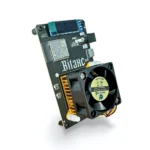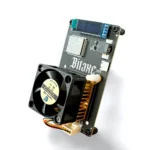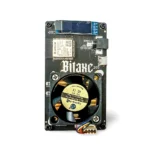How does Bitaxe Ultra help reduce Bitcoin mining pool dependencies?
How Does Bitaxe Ultra Help Reduce Bitcoin Mining Pool Dependencies?
Introduction: The Shift Toward Decentralized Mining
In the early days of Bitcoin, solo mining was the norm—anyone with a CPU or GPU could contribute to the network and earn block rewards. However, as mining difficulty increased, large-scale mining pools emerged, consolidating hash power and centralizing control over Bitcoin’s security. Today, a handful of dominant mining pools dictate a significant portion of block validation, raising concerns about censorship resistance and decentralization.
Enter the Bitaxe Ultra, the world’s first open-source ASIC miner designed to empower individual miners and reduce reliance on centralized pools. By combining efficient ASIC technology with self-sufficient mining capabilities, the Bitaxe Ultra allows users to participate in Bitcoin’s proof-of-work (PoW) mechanism independently. But how exactly does it achieve this? Let’s explore its unique features and operational advantages.
Breaking Free from Mining Pools: The Bitaxe Ultra Advantage
1. Solo Mining Without Compromise
Traditional mining pools aggregate hash power from thousands of miners, distributing rewards proportionally based on contributed work. While this increases reward frequency, it also means miners relinquish control over transaction selection and block construction.
The Bitaxe Ultra changes this dynamic by enabling direct block template mining. Instead of relying on a pool’s server to dictate transactions, the miner constructs its own blocks, submitting them directly to the Bitcoin network. This means:
- No pool fees (typically 1-3% of earnings).
- Full autonomy in transaction selection (resisting potential censorship).
- Direct block rewards (6.25 BTC per block, plus fees, instead of fractional payouts).
For miners who prioritize network sovereignty, this is a game-changer.
2. Open-Source Architecture for Transparency & Customization
Unlike proprietary ASIC miners that operate as black boxes, the Bitaxe Ultra’s open-source design allows users to inspect, modify, and optimize their mining operations. Key benefits include:
- Verifiable firmware: No hidden backdoors or imposed restrictions.
- Community-driven improvements: Developers worldwide can contribute enhancements.
- Custom mining strategies: Adjustable parameters for optimal efficiency.
This transparency ensures miners aren’t locked into a single pool’s ecosystem—they retain full control over their hardware and mining behavior.
3. Efficient ASIC Performance for Sustainable Solo Mining
One of the biggest hurdles for solo miners is the sheer difficulty of finding a block independently. With Bitcoin’s current hash rate, a low-powered device might take years to mine a block. However, the Bitaxe Ultra’s BM1366 ASIC chip delivers 500 GH/s at just 15W, making it one of the most energy-efficient miners in its class.
While solo mining remains probabilistic, the Bitaxe Ultra’s optimized power efficiency means miners can sustain operations longer without excessive electricity costs. For those running multiple units or small-scale mining farms, the cumulative hash rate improves success odds significantly.
4. Direct Network Participation Strengthens Bitcoin’s Decentralization
By processing their own block templates, Bitaxe Ultra miners contribute to network resilience in two key ways:
- Reducing Pool Dominance – More independent miners mean fewer entities controlling hash power.
- Enhancing Censorship Resistance – Miners choose which transactions to include, preventing external influence.
This aligns with Bitcoin’s original vision—where no single entity dictates network rules.

Practical Considerations for Bitaxe Ultra Miners
Is Solo Mining Profitable?
Solo mining is inherently unpredictable—you could find a block tomorrow or in six months. However, the Bitaxe Ultra’s low power consumption (just 15W) makes it feasible to run continuously without high overhead costs.
For miners who value independence over steady payouts, the trade-off is worthwhile. Additionally, joining a P2P mining protocol (like Stratum V2) can provide a middle ground—pooling hash power while still allowing miners to construct their own blocks.

Cooling & Deployment Flexibility
The Bitaxe Ultra’s compact design (10 x 6 cm, 73g) and optional Noctua fan cooling make it suitable for:
- Home mining setups (quiet and energy-efficient).
- Remote deployments (low power draw ideal for off-grid solar mining).
- Educational & development use (open-source nature supports experimentation).
Future-Proofing Through Open Development
Since the Bitaxe Ultra is community-driven, ongoing optimizations (such as firmware upgrades or new mining strategies) ensure longevity. Unlike closed-source miners that become obsolete when manufacturers stop supporting them, the Bitaxe Ultra can evolve alongside Bitcoin’s ecosystem.

Conclusion: A Step Toward True Mining Decentralization
The Bitaxe Ultra isn’t just another ASIC miner—it’s a philosophical shift in how Bitcoin mining operates. By enabling independent block production, eliminating pool dependencies, and fostering open-source innovation, it empowers miners to reclaim control over their participation in Bitcoin’s security.
While solo mining will never replace pools entirely, the Bitaxe Ultra proves that decentralized mining is still viable—and crucial for Bitcoin’s long-term health. For miners who value autonomy, transparency, and network resilience, this device represents a compelling step forward.
Are you ready to mine on your own terms? The Bitaxe Ultra makes it possible.